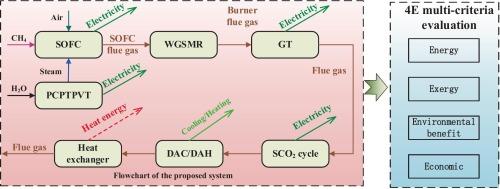基于零能耗CO2富集和级联余热回收的太阳能辅助SOFC-CCHP系统性能评价
IF 7.5
1区 工程技术
Q2 ENERGY & FUELS
引用次数: 0
摘要
为了解决太阳能利用不理想、能源密集型二氧化碳捕获和废热回收效率低下的挑战,本研究提出了一种新型的太阳能辅助固体氧化物燃料电池组合冷却、加热和电力系统。所提出的架构集成了:(1)部分覆盖的抛物面槽光伏/热集热器对蒸汽重整水进行预热,减少换热器的火用损失;(2)水气转换膜反应器在不增加能量输入的情况下,同时控制燃料气体组成和富集CO2,与常规系统相比减排79.68%;(3)耦合超临界CO2布雷顿循环、吸收式冷水机/热泵和热交换器的级联余热回收过程,以产生电力、加热/冷却和热水。综合性能评估采用4E(能源,能源,环境,经济)方法。在设计条件下,该系统的制冷和制热能效分别为87.5%和95.7%(包括所有热电输出),能效分别为57.4%和58.5%,可持续性指数为1.68,平均电力成本为0.0467美元/千瓦时,投资回收期为4.82年。参数分析表明,将SOFC工作温度从850°C提高到1100°C和太阳辐照度显著提高CO2减排和系统效率。这些结果表明,可再生热收集、原位二氧化碳捕获和级联废热利用的协同集成可以为分散的能源供应提供高性能、低碳的解决方案。本文章由计算机程序翻译,如有差异,请以英文原文为准。

4E-based performance evaluation of a solar-assisted SOFC–CCHP system integrating zero-energy CO2 enrichment and cascade waste heat recovery
To address the challenges of suboptimal solar energy utilization, energy-intensive CO2 capture, and inefficient waste heat recovery, this study proposes a novel solar-assisted solid oxide fuel cell combined cooling, heating, and power system. The proposed architecture integrates: (1) a partially covered parabolic trough photovoltaic/thermal collector to preheat steam reforming water, reducing heat-exchanger exergy losses; (2) a water–gas shift membrane reactor simultaneously controls fuel gas composition and enriches CO2 without additional energy input, achieving a 79.68 % emission reduction compared with conventional systems; and (3) a cascaded waste heat recovery process coupling a supercritical CO2 Brayton cycle, an absorption chiller/heat pump, and heat exchangers to produce power, heating/cooling, and hot water. Comprehensive performance is assessed employing 4E (energy, exergy, environmental, economic) method. Under design conditions, the system attains cooling and heating energy efficiencies of 87.5 % and 95.7 %, respectively (boundaries include all thermal and electrical outputs), exergy efficiencies of 57.4 % and 58.5 %, a sustainability index of 1.68, a levelized cost of electricity of 0.0467 $/kWh, and a payback period of 4.82 years. Parametric analyses show that increasing SOFC operating temperature from 850 °C to 1100 °C and solar irradiance significantly enhances CO2 mitigation and system efficiency. These results demonstrate that synergistic integration of renewable heat harvesting, in‐situ CO2 capture, and cascading waste heat utilization can provide a high‐performance, low‐carbon solution for decentralized energy supply.
求助全文
通过发布文献求助,成功后即可免费获取论文全文。
去求助
来源期刊

Fuel
工程技术-工程:化工
CiteScore
12.80
自引率
20.30%
发文量
3506
审稿时长
64 days
期刊介绍:
The exploration of energy sources remains a critical matter of study. For the past nine decades, fuel has consistently held the forefront in primary research efforts within the field of energy science. This area of investigation encompasses a wide range of subjects, with a particular emphasis on emerging concerns like environmental factors and pollution.
 求助内容:
求助内容: 应助结果提醒方式:
应助结果提醒方式:


